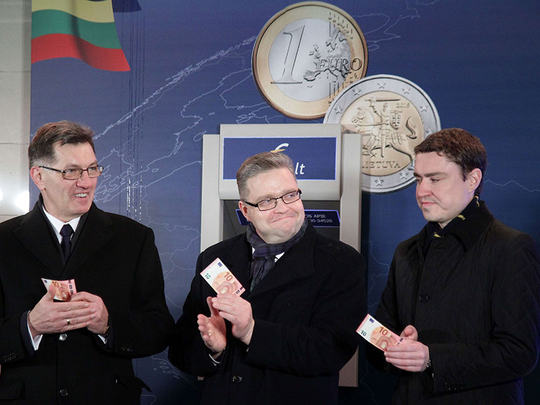
Vilnius: Lithuania switched over to the euro on Thursday, becoming the last Baltic nation to adopt Europe’s single currency in a bid to boost stability despite fears of inflation and eurozone debt woes.
Prime Minister Algirdas Butkevicius withdrew his first 10-euro bill (Dh44) from a Vilnius cash machine after midnight, as the euro currency area gained its 19th member and fireworks signed off a year marked by alarm over Russia’s role in the Ukraine conflict and its economic crisis.
“The euro will serve as a guarantee for our economic and political security,” he said at a ceremony alongside officials from fellow Baltic states Estonia and Latvia.
For a nation scarred by decades of Soviet occupation, eurozone entry is an important step and a symbol of “deeper economic and political integration with the West”, Lithuanian President Dalia Grybauskaite said earlier.
A total of 337 million Europeans now share the euro currency.
Other countries once behind the Iron Curtain now provide some of the leading figures in the European Union. Former Polish premier Donald Tusk took over as president of the European Council in December, while Latvia assumes the rotating EU presidency on January 1.
The three Baltic states broke free from the Soviet Union in 1990-1991 before joining the EU and NATO in 2004. Estonia and Latvia became eurozone members in 2011 and 2014.
“In joining the euro, the Lithuanian people are choosing to be part of an area of stability, security and prosperity,” EU economic affairs commissioner Pierre Moscovici said.
But in the run-up to the change from the litas to the euro, public support has wavered.
Fifty-three percent of the population of three million backed the euro and 39 percent were against, according to a November survey released by the central bank.
“Lithuania is a European Union country, and the currency must be the same. I really support it,” 44-year-old Robertas Rancys said.
But Vida Zurziene, in her 50s, said she would feel nostalgic about the litas: “I’m keeping some coins so I can show them to my grandchildren.”
“I think prices for services, like going to the hairdresser, will go up. But it will be easier to travel,” she told AFP.
Vilnius resident Teresa said she regretted losing a symbol of the country’s statehood.
“But it’s part of globalisation,” she added.
Lithuania’s membership comes as political uncertainty in Greece is once again stoking fears that the eurozone’s debt crisis could flare up.
Vilnius has already committed hundreds of millions of euros to the eurozone’s rescue fund for struggling members.
“Financial commitments are a huge burden and increase the country’s debt. I think we should have delayed entry,” financial analyst Valdemaras Katkus told AFP.
The litas has actually been pegged to the euro since 2002, making it dependent on the European Central Bank. Vilnius had hoped to adopt the euro in 2007 but failed to meet the inflation criteria.
The global financial crisis put the goal on hold in 2009, when Lithuania suffered a deep recession.
Biting austerity measures far exceeding any applied in Western Europe turned the economy around, resulting in recent growth of around three percent.
But social security cuts and other slashed public spending also encouraged record emigration to richer European nations such as Britain.
Most analysts say eurozone entry will foster export growth and encourage investment.
“Government, businesses and households will benefit from lower borrowing costs,” said Vaiva Seckute, a senior economist at Swedbank Macro Research.
Lithuania brought in 132 million individual banknotes - which are standard across the eurozone - from the German Bundesbank but minted its own euro coins.
They include the national coat of arms, a knight on horseback with sword and shield, which has appeared on the national currency since the 14th century.
The two currencies will circulate together for two weeks, while dual pricing will remain in shops until June.
The central bank had warned residents to take out enough cash for New Year festivities in case of technical disruptions.
The European Commission, meanwhile, draped a huge banner over its Brussels headquarters: “Welcome to the euro area, Lithuania!”












